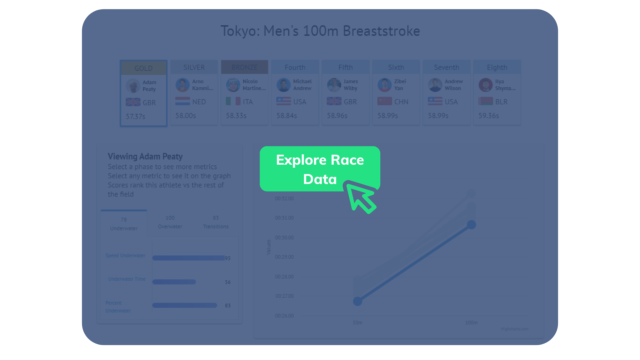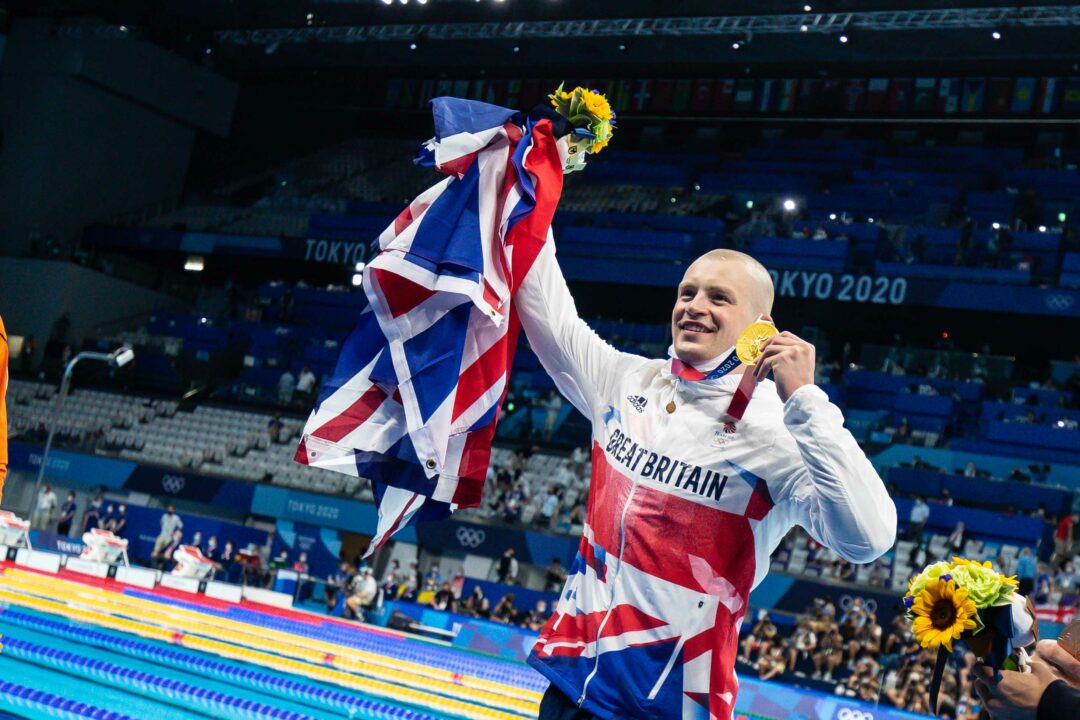We asked our swimming data partner TritonWear to help us with a deeper insight into performances and what makes elite swimmers fast and where they can improve. This is their TritonWear analysis.
Adam Peaty defends his reigning champion title in Tokyo: Exploring the performance with TritonWear.
The GOAT of Men’s 100 Breaststroke, Adam Peaty, defends his title in Tokyo and charges to the finish with a 57.37s, the only one to drop under 58 seconds in this race. Although his time was not Peaty’s fastest time, this race was about medaling, and he indeed delivered.
So what does it take to be the greatest of all time in the 100 Breaststroke? And how are Peaty’s competitors closing in on this event?
Nerd alert: we love data; this is why we use the same TritonWear data 30+ national federations trust when training these elite athletes, to explore the world’s best races and bring you all the insights into faster swimming.
Before we dive right into the data, here’s a quick look into the rankings:
1st Peaty Adam – 57.37
2nd Kamminga Arno – 58.00
3rd Martinenghi Nicolo- 58.33
4th Andrew Michael – 58.84
5th Wilby James – 58.96
6th Yan Zibei – 58.99
6th Wilson Andrew – 58.99
8th Shymanovich Ilya – 59.36
Unlocking performance with TritonWear
Let’s start with a quick overview of how to read the graphs below. Each circle represents a swimmer in the race, with the size representing their finishing place. So Peaty is the smallest bubble, and Ilya Shymanovich is the largest. The green bar on the box is the average across all of the athletes in the race.
Peaty, Kamminga and Martinenghi charged into the water from the start of the race with a fast reaction time (0.62s, 0.62s, 0.60s) paired with the highest *dive hang time of (0.42s, 0.49s, 0.42s). As a result, all three of them managed to carry some serious speed going in.
*Dive hang time = stayed longer during flight
 Looking at the overwater phase of the race, It comes as no surprise that Peaty’s dominating the overwater speed with the highest stroke rate, 56.11 cycle/min. Interestingly, Peaty and Andrew have the highest overwater speed of 1.69 m/s and 1.67m/s but are doing it differently.
Looking at the overwater phase of the race, It comes as no surprise that Peaty’s dominating the overwater speed with the highest stroke rate, 56.11 cycle/min. Interestingly, Peaty and Andrew have the highest overwater speed of 1.69 m/s and 1.67m/s but are doing it differently.
Although Peaty is moving fast through the water with his high SR, Andrew carries distance with each stroke with a phenomenal Distance per Cycle of 2.34m and only 30 strokes in total compared to the top 3 who averaged 40+ strokes.
 Unfortunately, despite being among the two fastest on the overwater portion of the race, Andrew’s underwater and transition phase cost him the podium. In detail, Andrew’s average speed underwater was 2.48 m/s ( Peaty 2.6m/s, Kamminga 2.6 m/s, Martinenghi 2.51 m/s), and his average transition time was 2.3s ( Peaty 1.41s, Kamminga 1.51s, Martinenghi 1.91s).
Unfortunately, despite being among the two fastest on the overwater portion of the race, Andrew’s underwater and transition phase cost him the podium. In detail, Andrew’s average speed underwater was 2.48 m/s ( Peaty 2.6m/s, Kamminga 2.6 m/s, Martinenghi 2.51 m/s), and his average transition time was 2.3s ( Peaty 1.41s, Kamminga 1.51s, Martinenghi 1.91s).
 As for Kamminga and his chance at gold, it seems that it came down to his overwater speed. Although Kamminga matched Peaty in the speed underwater, with both of them clocking 2.6 s/m, his overwater speed of 1.65m/s was not enough to dethrone the reigning champion of this event.
As for Kamminga and his chance at gold, it seems that it came down to his overwater speed. Although Kamminga matched Peaty in the speed underwater, with both of them clocking 2.6 s/m, his overwater speed of 1.65m/s was not enough to dethrone the reigning champion of this event.
To join in on the fun and draw your own conclusions,
head over to TritonWear’s epic Race Analysis page
to explore every detail of each swimmer’s race data.
 How TritonWear Can Help You Swim Faster
How TritonWear Can Help You Swim Faster
Even though these athletes are elite at the highest level, we analyzed their data to show what is possible with data-driven insights.
TritonWear is a sleek wearable device and app that helps you train well consistently, so you can swim faster. It captures and relays 30+ data points in real-time to any mobile device on deck. Triton Score analyzes your data and provides you with actionable insights highlighting exactly where you’re excelling and what you need to improve on to swim faster.
Athletes: Get started with as little as $20/month and receive a free unit (included with your membership).
Coaches: Create highly personalized winning strategies for individual swimmers and the team as a whole with data-driven insights. 30+ national federations trust us to help them train these elite athletes, you can too.



Not sure if it’s due to him having a son or just the pandemic making things harder over the past 18 months, but he seemed more emotional than usual for the victory.
Any data to support that observation?